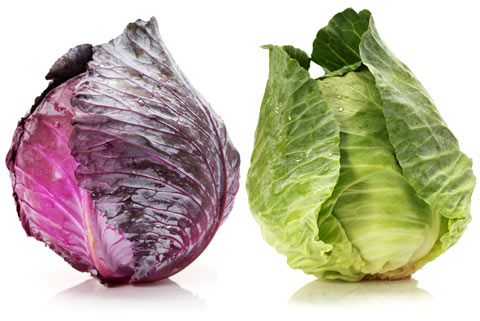Anticancer Cabbage

Fun Facts:
Early German settlers are said to have brought cabbage and sauerkraut to America. (i.1)
Cabbage and sauerkraut (rich in vitamin C) might not sound like appealing foods for a long ship voyage, but early Dutch and English ships relied on them to stave off scurvy and even as dressings for wounds. (i.1, 130)
Cabbage, which is in the Brassicaceae plant family, is rich in vitamin A and vitamin C, high in minerals like potassium, and low in calories — a combination that makes it quite nutritious and healthy. In addition, cabbage contains glucosinolate plant compounds that the body converts to isothiocyanates, which display special cancer-fighting and detoxification properties. Other phytonutrients in cabbage add to its antioxidant and anti-inflammatory arsenal that could also help prevent the development of cancer. (i.129)
People have used cabbage since time immemorial as a form of food and medicine. Celtic travelers are thought to have brought wild cabbage to Europe about 600 BC. However, others suggest the vegetable has been cultivated for over 4000 years and was brought to Europe by Hun and Mongol soldiers carrying fermented/pickled cabbage for sustenance. Both ancient Roman and Greek civilizations used it to treat a wide variety of ailments. Wild cabbage has loose leaves resembling the related cruciferous plant kale instead of a compacted head of leaves. (i.1, 129, 130)
Common Types of Cabbage
Cabbages are generally either yellowish to green or red to purple in color with heads varying between 15 and 30 centimeters. There are three basic types of Brassica oleracea cabbage — Savoy, green, and red — with each one containing different types of glucosinolate phytonutrients. Red and green cabbages have relatively smooth leaves. Savoy cabbage (Brassica oleracea var capitata) is a winter cabbage with crinkled leaves ranging in color from dark green outer leaves to yellowish-green closer to the center of the head. It has a more delicate taste than the robust flavor and texture of red or green cabbages. (i.131)
How Cabbage Helps Prevent Cancer
Diet is important in the prevention of cancer and some experts suggest that a healthy diet could prevent more than a third of cancer-related deaths. Fruits and vegetables form an important part of such a diet, and cabbage contains at least 11 out of the 15 groups of plant compounds that studies suggest can help prevent cancer. (i.132)
Cabbage is high in fiber and omega-3 fatty acids, and is a good to excellent source of vitamin A, vitamin B6, vitamin K, and vitamin C, as well as calcium, folate, niacin, and thiamine. This cruciferous vegetable also has impressive phytonutrient constituents. Cabbage plays an important role in the prevention of cancer because of its richness in antioxidants, glucosinolate polyphenols, and anti-inflammatory compounds. In fact, its antioxidant properties are largely attributed to its high polyphenol content. The antioxidants in cabbage not only protect against free radical damage that can lead to cancer, they also stimulate production of the antioxidants produced in the body. (i.131-133)
Potent Cancer-Fighting Components in Cabbage
Glucosinolates belong to an important group of plant phytonutrients in terms of anticancer properties, and cabbage has several types of this powerful polyphenol: (i.129)
- Glucobrassicin (specifically in Savoy cabbage).
- Glucoraphanin (found in red cabbage).
- Glucotropaeolin (specifically in green cabbage).
- Sinigrin (especially in green and Savoy cabbages).
Sinigrin Fights Breast and Prostate Cancers
Although all cabbages contain sinigrin, Savoy cabbage is especially rich in this type of glucosinolate. The body converts sinigrin to allyl isothiocyanate (AITC), which population studies suggest may help prevent cancers of the bladder, colon, lung, and prostate. Preclinical studies indicate that indole-3-carbinol, a compound formed from the isothiocyanates in Savoy cabbage, may be able to inhibit ER-sensitive breast cancer in non-smokers at higher risk for the disease and prevent precancerous lesions in the cervix from progressing to cervical cancer. Animal studies indicate that the same compound could reduce the risk of development or recurrence of prostate cancer, including for aggressive types of the disease. (i.129, 131, 134, 135)
Antitumor Activity of Glucosinolates
Other glucosinolates are also eventually converted into different isothiocyanates, which all exhibit antitumor activity. Some may be anti-inflammatory, while others have detoxifying properties. In fact, lab studies suggest that isothiocyanates may also help stop different types of existing cancers from progressing, including those in the brain, breast, bladder, colon, and prostate. Isothiocyanates have also been shown to inhibit types of melanoma cells that aggressively metastasize to the lung. (i.129, 131, 134, 135)
Antitumor Phytonutrients
Other important cancer-fighting polyphenols in cabbage include: (i.53, 99, 100, 117, 129, 136-139)
- Anthocyanins. Responsible for the deep red and purples found in some cabbages, these polyphenols are powerful antioxidants and anti-inflammatory compounds.
- Apigenin. A flavone type of flavonoid that suppresses tumor growth, possibly by inhibiting deregulated cell cycle proteins, and induces breast cancer cell death — including in Her2 lines. Population studies also show an inverse association between eating foods high in apigenin and risk of cancer (e.g., of the breast, colon, lung, and ovary).
- Carotenoids. A group of pigment compounds in fruits and vegetables, there are over 600 different carotenoids that make vegetables and fruits deep yellow, orange, and red as they ripen. However, carotenoids are also contained in some green plant leaves too (though to a lesser extent then the green chlorophyll pigments). Cabbage contains beta-carotene, lutein, neoxanthin, violaxanthin, and zeaxanthin, all of which have antioxidant properties. In general, the darker green cabbages have more carotenoids than lighter green types. Studies show that carotenoids have anticancer effects, but experts suggest that consuming foods such as a variety of cabbages with a mix of different carotene and xanthophyll-type carotenoids may be more beneficial than limiting your diet to a particular carotenoid. In fact, human studies show that beta-carotene supplementation (by itself) is associated with increase lung cancer risk in heavy smokers and asbestos workers.
- Luteolin. A flavone that has anti-inflammatory properties, luteolin was one of five flavonoids (in vegetables and fruit) shown to be associated with lower cancer risk in a 25-year prospective population study involving 878 men — especially lung cancer. Other studies amongst women showed lower risk of ovarian and breast cancer.
- Myricetin. A flavonol-type polyphenol found in red cabbage, myricetin has antioxidant properties and lab studies show it can kill certain types of leukemia cells by negatively affecting their energy-producing mitochondria. Long-term prospective as well as case-based population studies indicate increased consumption of foods that contain myricetin correlates to lower risk of cancer, including lung, ovarian, and breast tumors.
- Sinapic acid. Chinese cabbage is particularly high in this phenolic acid, which is actually a non-flavonoid type of polyphenol. Studies show that phenolic acids inhibit certain enzymes and growth factors that promote metastasis.
- S-methylcysteine sulfoxide. Present in cruciferous vegetables, this compound was shown in animal and human studies to protect against DNA damage (which can lead to cancer). Compounds containing sulfur and histidine in cabbage have been shown to inhibit tumor growth and boost the immune system.
Adding Cabbage to Your Diet
For the best texture, taste, and quality, be sure to pick firm, heavy cabbage heads with colorful, crisp and shiny leaves. Avoid heads that have severely damaged outer leaves, which can be indicative of insect damage inside. Cabbage leaves start losing vitamin C soon after cutting; hence it is not a good idea to purchase pre-cut ones. The best Savoy cabbages are usually found in the market between October and February. (i.129, 140)
Store red or green uncut cabbage heads in the refrigerator in a plastic bag for up to 2 weeks; Savoy cabbage can be kept fresh for about one week in the same fashion. (i.129, 140)
How to Prepare Cabbage: Plan Ahead for Best Results
When you want to add cabbage to a meal, plan to add up to 30 minutes for prep time before cooking or serving raw in a salad or slaw and follow these tips for best results: (i.129, 140, 141)
- Cabbage should be cut into wedges (discarding the hard core) and then washed under running water.
- Soaking the head in either vinegar or saline water for about 15 to 20 minutes will take care of any insects or worms lurking inside if you see insect damage on the outer leaves.
- Using a stainless steel knife to shred or cut cabbage helps avoid the reaction of phytonutrients with carbon steel that makes the leaves turn black.
- Be sure to let cut cabbage sit for 5-10 minutes before cooking to give its activated natural enzymes time to start converting glucosinolates to the more beneficial form (isothiocyanates).
- Choose a cooking method that takes the shortest time in order to maximize cabbage's cancer-fighting benefits. Studies have shown that steaming, microwaving, or stir-frying Brassica vegetables helps to preserve anti-cancer glucosinolates far better than boiling. University of Warwick researchers found that boiling damages anti-cancer properties in different Brassica vegetables. Boiling them for just five minutes results in losses of between 20% and 30% of helpful phytonutrients.
Use the following cooking times as a good rule of thumb: (i.129, 141, 142)
| Method | Maximum Cooking Time To Preserve Glucosinolates |
|---|---|
| Microwave (with no more than 10% water) | 3 minutes |
| Steam | 7 minutes |
| Stir-Fry | 5 minutes |
Avoid cooking cabbage in an aluminum pot — it increases the chemical reaction that releases the unpleasant-smelling volatile acids. But don't try smothering the smell with a lid, or you'll get limp, drab cabbage. (i.143)
According to World Health Foods' recommendations, at least a serving of about 1 ½ cups of vegetables should be eaten two to three times per week. Ideally, a serving should be two cups of vegetables between four and five times a week. Other oncology experts suggest consuming at least 8-10 servings a day of fruit and vegetables at a minimum to maximize dietary cancer prevention. (i.134)
Cancer-Fighting Combinations
Research evidence indicates that combining cruciferous vegetables such as cabbage with foods high in lycopene (e.g., tomatoes or tomato sauce) can significantly enhance the anti-cancer properties of both. (i.134)
Try mixing up your cabbage colors in a salad to make the most of cabbage's cancer-fighting benefits. Green cabbages contain more glucosinolates, while red cabbage offers the super-antioxidant potency of anthocyanins. (i.133)
Growing Cabbage
The seeds can either be planted directly in warm weather, or put in a nursery and then transplanted between 30 and 50 days later when the seedlings are roughly 15 cm high. Early season Savoy cabbage seedlings typically need 8 weeks to mature for transplanting, while late spring plantings take only 5-6 weeks. (i.144, 145)
Cabbage crops are harvested between 70 and 130 days after transplanting, depending on the type (with storage varieties the last to be harvested). It is important to have good drainage and a soil pH level of 7 to 7.5. Rotate cabbage crops with non-Brassica plants to minimize the insect problems that cabbages are prone to. (i.144, 145)



